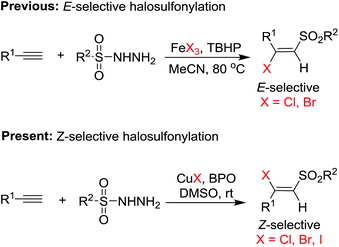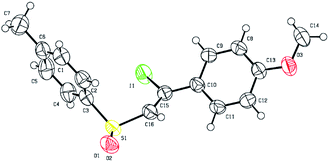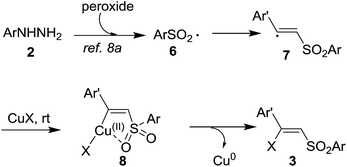Stereoselective Z-halosulfonylation of terminal alkynes using sulfonohydrazides and CuX (X = Cl, Br, I)†
Jie-Ping Wan*,
Deqing Hu,
Feicheng Bai,
Li Wei and
Yunyun Liu*
College of Chemistry and Chemical Engineering, Jiangxi Normal University, Nanchang 330022, P.R. China. E-mail: wanjieping@jxnu.edu.cn; chemliuyunyun@jxnu.edu.cn
First published on 28th July 2016
Abstract
The Z-selective halosulfonylation of terminal alkynes has been achieved via the halosulfonylation of terminal alkynes by using sulfonohydrazides and copper(I) halides (CuI, CuBr and CuCl), which enables the generally applicable synthesis of halogenated vinyl sulfones with satisfactory efficiency.
The difunctionalization of alkynes is a crucial strategy in modern organic synthesis by providing straightforward and flexible accesses to polyfunctionalized alkene derivatives.1 Among the various known patterns of alkyne difunctionalization, halosulfonylation which provides halogenated vinyl sulfones has received extensive attention in recent years because of the prevalent presence of sulfonylated vinyl substructures in biologically functional molecules as well as their valuable application in organic synthesis.2 There have been longstanding efforts made by chemists for the synthesis of these halogenated vinyl sulfones during the past decades, the survey on related literature shows that these halogenated vinyl sulfones can be synthesized by the electrophilic halogenation of sulfonylated vinyl zirconium,3 the oxidation of β-halogenated vinyl sulfides,4 and more universally, the difunctionalization of alkynes using various sulfonyl reagents.Generally, the halosulfonylation using sulfonyl halides,5 sodium sulfinates/halogen source,6 sulfinic acid/iodine7 and sulfonohydrazides have all been known as practical routes to halogenated vinyl sulfones.8 While these known protocols provide enriched options in the synthesis of these functionalized compounds, an amazing fact was that almost all these known methods give vinyl sulfone products with E-selectivity, and the only known example of Z-selective alkyne difunctionalization toward the β-halo vinyl sulfone synthesis has been reported by Liang and co-workers wherein sulfonyl chloride is used as the difunctionalizing reagents in the presence of copper catalyst, stoichiometric Me2S ligand with 110 °C heating.5d On the other hand, the reactions employing stable sulfonohydrazides as partners are known to provide selectively E-configurated products (Scheme 1).8 Additionally, another challenge in the difunctionalization-based synthesis of halogenated vinyl sulfones is that almost no method showing general applicability to the synthesis of chloro-, bromo- and iodo-vinyl sulfones is present available because of either the limited tolerance of the catalytic conditions or the unavailability of related halogen sources. In this regard, developing alkyne halosulfonylation reactions of Z-selectivity and/or general application to the synthesis of Cl, Br and I functionalized vinyl sulfones is presently an issue of urgent significance. Upon our recent research interest in the sulfonohydrazide-based synthesis9 and related reactions involving efficient C–S bond formation,10 we report herein an unprecedented and generally applicable Z-selective halosulfonylation reactions of alkynes using CuX (X = Cl, Br, I) as halogen sources as well as the switchable alkyne hydrosulfonylation reactions (Scheme 1).
Originally, the reaction between phenylacetylene 1a and tosyl hydrazine 2a was conducted in the presence of CuI, BPO (benzoyl peroxide), and CuI/BPO, respectively. The results indicated that the presence of both CuI and BPO enabled the production of (Z)-iodosulfonylated styrene 3a with moderate yield (entries 1–3, Table 1). While CuI was a mandatory component acting as both the catalyst and iodine source in the reaction, we then examined the effect of peroxide to the reaction. It was found that peroxides such as hydrogen peroxide and TBHP (t-butyl hydrogen peroxide) was not practical for the target transformation. Interestingly, the variation on the reaction medium with various organic solvents, including DMF, ethyl lactate (EL), EtOH, water, dichloromethane and toluene suggested that none of these solvent could mediate the reaction, implying the specific function of DMSO for this reaction probably by acting as a ligand to stabilize the copper catalyst (entries 6–11, Table 1). While the entry increasing the amount of CuI did not improve the yield of 3a (entry 12, Table 1), increasing the loading of 2a to 1.5 eq. led to evident improvement on the yield of 3a (entries 13–14, Table 1). Finally, the variation on the amount of BPO was not able to further improve the reaction (entries 15–16, Table 1). An additional entry employing molecular iodine as the halogen source in the presence of catalytic amount of CuI resulted in the production of complex mixture (entry 17, Table 1). The Z-configuration of 3a was clearly assigned by full spectroscopic analysis and the comparison of related data with those of E-isomer reported in literature.4c The X-ray analysis on the single crystal of the synthesized product 3i was a further confirmation on the assignment (Fig. 1).
| Entry | Oxidant | Solvent | Yieldb (%) |
|---|---|---|---|
| a General conditions: 1a (0.2 mmol), 2a (0.2 mmol), CuI (0.2 mmol), oxidant (0.2 mmol), stirred at rt for 12 h in 2.0 mL solvent, nr = no reaction; EL = ethyl lactate.b Yield of isolated product based on 1a.c No CuI was employed.d The CuI loading was 0.3 mmol.e The loading of 2a was 0.3 mmol.f The loading of 2a was 0.4 mmol.g The loading of BPO was 0.1 mmol.h The loading of BPO was 0.3 mmol.i Catalytic amount of CuI (10 mol%) in the presence of 1 eq. mole of I2 (0.2 mmol), and complex mixture was formed. | |||
| 1c | BPO | DMSO | nr |
| 2 | No | DMSO | Trace |
| 3 | BPO | DMSO | 57 |
| 4 | TBHP | DMSO | 21 |
| 5 | H2O2 | DMSO | Trace |
| 6 | BPO | DMF | Trace |
| 7 | BPO | EL | nr |
| 8 | BPO | EtOH | nr |
| 9 | BPO | H2O | nr |
| 10 | BPO | CH2Cl2 | nr |
| 11 | BPO | Toluene | nr |
| 12d | BPO | DMSO | 59 |
| 13e | BPO | DMSO | 85 |
| 14f | BPO | DMSO | 82 |
| 15g | BPO | DMSO | 70 |
| 16h | BPO | DMSO | 75 |
| 17i | BPO | DMSO | nr |
To examine the application scope, the synthesis of diverse Z-halogenated vinyl sulfones 3 was conducted by employing a variety of different terminal alkynes 1 and sulfonohydrazides 2. As shown in Table 2, under the optimized conditions, a number of Z-alkene products 3 were smoothly synthesized with generally good to excellent yields. Aryl terminal alkynes and sulfonohydrazides containing various functional groups such as alkyl, alkoxyl, halogen etc. were all well tolerated. Considerably lower yield of related product was acquired when phenylacetylene containing strong electron withdrawing group was used (3ai, Table 2). A highly notable fact of the present protocol lied in its universal applicability not only for the synthesis of iodinated products (3a–3s, Table 2), but also the brominated (3t–3z, 3aa–3ac, Table 2) and chlorinated products (3ad–3ah, Table 2). Therefore, along with the hardly accessible Z-selectivity,11 the general application scope to different halogen sources remarks another desirable feature of the present alkyne halosulfonylation protocol.12 No expect halosulfonylation was observed when 1,2-diphenylethyne, a typical internal alkyne, aliphatic terminal alkyne or phenylacetylenes containing sensitive groups (3-hydroxyl phenylacetylene, 3-aminophenylacetylene and 2-formyl phenylacetylene, respectively) were subjected with tosyl hydrazine and CuI and standard reaction conditions. In addition, the reactions employing methanesulfonohydrazide didn't provide expect transformation, either.
| R | Ar | X | Product | Yieldb (%) |
|---|---|---|---|---|
| a General conditions: 1 (0.2 mmol), 2 (0.3 mmol), CuX (0.2 mmol) and BPO (0.2 mmol) in DMSO (2 mL), stirred at room temperature for 12 h.b Yield of isolated product based on 1. | ||||
| H | 4-CH3C6H4 | I | 3a | 85 |
| H | Ph | I | 3b | 71 |
| 4-CH3 | Ph | I | 3c | 86 |
| 3-CH3 | Ph | I | 3d | 74 |
| 3-F | Ph | I | 3e | 65 |
| 2-F | Ph | I | 3f | 63 |
| 4-Cl | Ph | I | 3g | 81 |
| 4-Br | Ph | I | 3h | 83 |
| 4-CH3O | 4-CH3C6H4 | I | 3i | 79 |
| 4-Cl | 4-CH3C6H4 | I | 3j | 73 |
| 4-Br | 4-CH3C6H4 | I | 3k | 80 |
| 4-CH3 | 4-CH3OC6H4 | I | 3l | 68 |
| 4-Cl | 4-CH3OC6H4 | I | 3m | 66 |
| 4-CH3 | 4-ClC6H4 | I | 3n | 71 |
| 4-Cl | 4-ClC6H4 | I | 3o | 56 |
| 4-CH3 | 4-CNC6H4 | I | 3p | 69 |
| 4-CH3 | 4-NO2C6H4 | I | 3q | 65 |
| 4-Cl | 2-CH3C6H4 | I | 3r | 58 |
| 4-CH3 | 2-FC6H4 | I | 3s | 61 |
| 4-CH3 | Ph | Br | 3t | 83 |
| 4-CH3O | Ph | Br | 3u | 72 |
| 4-Cl | Ph | Br | 3v | 64 |
| 3-CH3 | Ph | Br | 3w | 78 |
| H | 4-CH3C6H4 | Br | 3x | 73 |
| 4-CH3 | 4-CH3C6H4 | Br | 3y | 75 |
| 4-Cl | 4-CH3C6H4 | Br | 3z | 62 |
| 4-Br | 4-CH3C6H4 | Br | 3aa | 59 |
| 4-CH3 | 2-Naphthyl | Br | 3ab | 76 |
| 4-Cl | 2-Naphthyl | Br | 3ac | 71 |
| H | Ph | Cl | 3ad | 70 |
| 4-CH3 | Ph | Cl | 3ae | 68 |
| 4-Cl | Ph | Cl | 3af | 59 |
| 4-Br | Ph | Cl | 3ag | 62 |
| 4-Br | 4-CH3C6H4 | Cl | 3ah | 62 |
| 4-CN | 4-CH3C6H4 | I | 3ai | 30 |
Considering the rare availability of these Z-halogenated vinyl sulfones determined by the lack of synthetic methodology, primary investigation on their synthetic applications of the Z-vinyl sulfone was then conducted. For example, products 3a could undergo Sonogashira coupling reaction with terminal alkyne 1b to provide corresponding conjugate Z-enyne 4 (eqn 1). In addition, the copper-catalyzed C(sp2)–I hydroxylation of 3a could provide efficiently α-tosyl phenylacetone 5 (eqn 2).
 | (1) |
 | (2) |
To illustrate the possible routes of transformation, the mechanism has been proposed on the basis of the outcomes obtained in our work and related literatures (Scheme 2).5d,8a In known reports of alkyne difunctionalization involving the sulfonyl reagents, the sulfone radical is a generally recognized intermediate. As proposed in the previous E-selective halosulfonylation of alkynes using sulfonohydrazides in the presence of a peroxide and FeX3 (X = Cl, Br),8a the sulfonyl radical 6 is proposed to be produced from the sulfonohydrazide in the presence of peroxide (BPO). With the activation CuX, the reaction of alkyne with sulfonyl radical 6 provides vinyl sulfone radical 7. The incorporation of 7 to CuX may then results in the formation of Cu(II)-species 8 via oxidative addition. The Cu⋯O interaction forming cyclic structure in 8 accounts for the Z-selectivity of this vinyl sulfone formation. Subsequently, the reductive elimination of 8 provides Z-halogenated vinyl sulfone products 3.
Conclusions
In conclusion, by employing Cu(I) halides as the halogen sources and sulfonohydrazides as reaction partners, the hardly accessible Z-selective halosulfonylation of terminal alkynes has been successfully achieved in the presence of BPO at room temperature. The novel Z-stereoselectivity, mild reaction conditions and the general tolerance to halogen sources (Cl, Br, I) have featured the high potential of the present method in the synthesis of diverse halogenated vinyl sulfones.Acknowledgements
This work is financially supported by the National Natural Science Foundation of China (21562024) and Natural Science Foundation of Jiangxi Province (20151BAB203008).Notes and references
- (a) Q. Lu, J. Zhang, G. Zhao, Y. Qi, H. Wang and A. Lei, J. Am. Chem. Soc., 2013, 135, 11481 CrossRef CAS PubMed; (b) B. Yao, Q. Wang and J. Zhu, Angew. Chem., Int. Ed., 2012, 51, 5170 CrossRef CAS PubMed; (c) Z. Chen, J. Li, H. Jiang, S. Zhu, Y. Li and C. Qi, Org. Lett., 2010, 12, 3262 CrossRef CAS PubMed; (d) H.-L. Hua, Y.-T. He, Y.-F. Qiu, Y.-X. Li, B. Song, P. Gao, X.-R. Song, D.-H. Guo, X.-Y. Liu and Y. M. Liang, Chem.–Eur. J., 2015, 21, 1468 CrossRef CAS PubMed; (e) P.-P. Tian, S.-H. Cai, Q.-J. Liang, X.-Y. Zhou, Y.-H. Xu and T.-P. Loh, Org. Lett., 2015, 17, 1636 CrossRef CAS PubMed; (f) F. Zhao, D. Zhang, Y. Nian, L. Zhang, W. Yang and H. Liu, Org. Lett., 2014, 16, 5124 CrossRef CAS PubMed; (g) J. Lai, L. Tian, X. Huo, Y. Zhang, X. Xie and S. Tang, J. Org. Chem., 2015, 80, 5894 CrossRef CAS PubMed.
- (a) D. C. Meadows and J. Gervay-Hague, Med. Res. Rev., 2006, 26, 793 CrossRef CAS PubMed; (b) J. T. Palmer, D. Rasnick, J. L. Klaus and D. Bromme, J. Med. Chem., 1995, 38, 3193 CrossRef CAS PubMed; (c) M. C. Carreno, Chem. Rev., 1995, 95, 1717 CrossRef CAS; (d) M. N. Noshi, A. El-Awa, E. Torres and P. L. Fuchs, J. Am. Chem. Soc., 2007, 129, 11242 CrossRef CAS PubMed; (e) J. N. Desrosiers and A. B. Charette, Angew. Chem., Int. Ed., 2007, 46, 5955 CrossRef CAS PubMed.
- (a) X. Huang and D. Duan, Chem. Commun., 1999, 1741 RSC; (b) X. Huang, D. Duan and W. Zheng, J. Org. Chem., 2003, 68, 1958 CrossRef CAS PubMed.
- (a) M. Iwasaki, T. Fujii, K. Nakajima and Y. Nishihara, Angew. Chem., Int. Ed., 2014, 53, 13880 CrossRef CAS PubMed; (b) M. Iwasaki, T. Fujii, A. Yamamoto, K. Nakajima and Y. Nishihara, Chem.–Asian J., 2014, 9, 58 CrossRef CAS PubMed; (c) Y.-M. Lin, G.-P. Lu, C. Cai and W.-B. Yi, Org. Lett., 2015, 17, 3310 CrossRef CAS PubMed.
- (a) W. T. Truce and G. C. Wolf, J. Org. Chem., 1971, 36, 1727 CrossRef CAS; (b) Y. Amiel, Tetrahedron Lett., 1971, 12, 661 CrossRef; (c) Y. Amiel, J. Org. Chem., 1974, 39, 3867 CrossRef CAS; (d) X. Liu, X. Duan, Z. Pan, Y. Han and Y. Liang, Synlett, 2005, 1752 CAS; (e) X. Zeng, L. Ilies and E. Nakamura, Org. Lett., 2012, 14, 954 CrossRef CAS PubMed.
- (a) V. Nair, A. Augustine, T. G. George and L. G. Nair, Tetrahedron Lett., 2001, 42, 6763 CrossRef CAS; (b) V. Nair, A. Augustine and T. D. Suja, Synthesis, 2002, 2259 CrossRef CAS; (c) P. Katrum, S. Chiamapanichayakul, K. Korworapan, M. Pohmakotr, V. Reutrkul, T. Jaipetch and C. Kuhakarn, Eur. J. Org. Chem., 2010, 5633 CrossRef; (d) N. Taniguchi, Synlett, 2011, 1308 CrossRef CAS; (e) T. Sawangphon, P. Katrum, K. Chaisiwamongkhol, M. Pohmakotr, V. Reutrakul, T. Jaipetch, D. Soorukram and C. Kuhakarn, Synth. Commun., 2013, 43, 1692 CrossRef CAS; (f) N. Taniguchi, Tetrahedron, 2014, 70, 1984 CrossRef CAS.
- W. Wei, J. Wen, D. Yang, H. Jing, J. You and H. Wang, RSC Adv., 2015, 5, 4416 RSC.
- (a) X. Li, X. Shi, M. Fang and X. Xu, J. Org. Chem., 2013, 78, 9499 CrossRef CAS PubMed; (b) X. Li, S. Xu and X. Shi, Tetrahedron Lett., 2013, 54, 3071 CrossRef CAS; (c) N. J. Victor, J. Gana and K. M. Muraleedharan, Chem.–Eur. J., 2015, 21, 14742 CrossRef CAS PubMed.
- J.-P. Wan, S. Cao and Y. Liu, J. Org. Chem., 2015, 80, 9028 CrossRef CAS PubMed.
- (a) J.-P. Wan, S. Zhong, L. Xie, X. Cao, Y. Liu and L. Wei, Org. Lett., 2016, 18, 584 CrossRef CAS PubMed; (b) J.-P. Wan, Y. Zhou, Y. Liu and S. Sheng, Green Chem., 2016, 18, 402 RSC; (c) Y. Liu, H. Wang, X. Cao, Z. Fang and J.-P. Wan, Synthesis, 2013, 45, 2977 CrossRef CAS.
- CCDC 1474142 (3i) contains the supplementary crystallographic data for this paper.
- According to the TLC analysis, small amount of E-isomers were observed in some entries, but none of them were isolable by column chromatography (very low yield) in the present scale of experiment.
Footnote |
| † Electronic supplementary information (ESI) available: General experimental information, procedure for the synthesis of 3 and 4, 1H and 13C NMR spectra of all products and the crystallographic data of 3i. CCDC 1474142. For ESI and crystallographic data in CIF or other electronic format see DOI: 10.1039/c6ra13737g |
| This journal is © The Royal Society of Chemistry 2016 |





